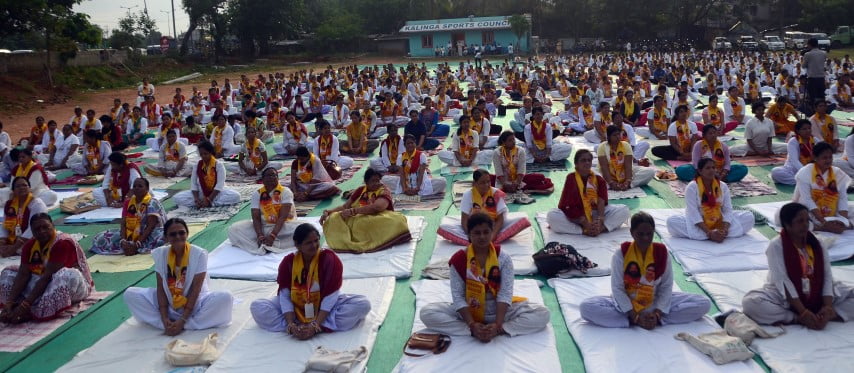Yoga, The Perfect Way To Unlock Yourself Amid COVID-19 Lockdown

The COVID-19 crisis and subsequent lockdown has resulted in entire populations around the world being forced into confinement. Yet, the wheels of the workaday world have not stopped turning.
Combining work while living and working at home has thrown up challenges hitherto unnoticed and undocumented. This, as reports have shown, has led to a spike in domestic violence and child abuse. While it will take time to gauge the gravity of the impact on society’s mental and emotional health, yoga, dance and art are disciplines that offer a window of hope on how to maintain one’s emotional equilibrium, if one is willing to devote time and single-minded attention.
Yoga
All life is Yoga, Sri Aurobindo
This ancient Indian practice has helped humans to not only improve physical but also mental health and overall wellbeing. In the ancient times, sages would retreat into the mountains to perfect their ‘yoga sadhana’ or training in yogic practices.
Indrajit Chakraborty, a yoga teacher who conducts online classes and is the founder of Ranchi Yoga Culture (ryogaculture.com), says: “The COVID-19 crisis is a reminder that people cannot take health lightly. They have to build immunity, and that is possible only through exercising and practising yoga every day.”
He says during lockdown, people are bound to feel frustrated, anxious, or agitated as the sense of security one takes for granted is lost. Livelihood options are threatened, and the fear of disease is not something easy to live with. “I would suggest an hour of yoga, in the morning and also in the evening.”
“One should start with some free-hand stretching exercises or on-the-spot jogging before moving on to 6-10 rounds of the Surya Namaskar. A few rounds of four to five simple asanas will help maintain flexibility and improve overall health. For example, ushtrasana (camel pose), markatasana (spinal twist), padmasana (lotus posture), pawan muktasana (air release posture), gomukhasana (cow face pose), vrikshasana (tree pose), matsyasan (fish pose), dhanurasan (bow pose), vajrasan (thunderbolt pose), titliasan (butterfly pose), among others, may be practised. Yog nidra (sleeping consciously) is particularly helpful for those suffering from anxiety or stress. What is important is to do these asanas with full concentration.”
He advises patients with any pre-existing condition to seek medical advice before starting yoga and to beginners that they must begin very slowly and focus on breathing. After about 40 to 45 minutes of yogasanas, one must sit quietly, listen to some soothing music as it is therapeutic, and then begin a round of pranayam, says Chakraborty. “Anulom-Vilom (alternate nostril breathing), kapal bhati (the shining forehead), bhastrika (bellow’s breath), chandrabhedan (left nostril breath), suryabhedan (right nostril breath), bhramari (humming bee breath), shitala pranayam (cooling breath), are very helpful and if practised regularly can bring peace of mind. After pranayam, a yoga practitioner must spend at least 10-15 minutes in meditation, he adds.
“Yoga is about the right attitude to life. So, a regular practitioner of yoga is one who is mentally disciplined. During the lockdown simple tasks around the house must be shared and done mindfully. Each member must contribute, and the burden of domestic work should not fall on the woman. Yoga brings about self-awareness and pranayam and meditation are the best tools for anger management.”
Put on your dancing shoes and dance away your blues
Ashwin Yadav, Artistic Director, Artistic Motion Studio, New Delhi is a firm believer in the healing power of dance. “People who stay at home all day, find it difficult to cope with their inner demons. Dance brings out your inner child. Anybody can dance. I have seen people coping with anger issues or even depression benefit from dance. Dance teaches you not only to tap your feet but also gives you wings to fly away into the world of your imagination. So, dance in sickness and in health!” he says.
Watch Ashwin and his team dance at: https://youtu.be/bG0ljT1JLFs
A little fragrance always lingers in the hand that gives roses
Delhi-based calligrapher Shipra Rohatgi completed the task of stitching 50,000 cotton masks to raise funds for frontline workers battling the COVID-19 crisis. “Just the thought that I am not engaged in a commercial activity and am doing something solely to save lives, is therapeutic. I am healing myself and through this work, I find a deep sense of peace and positivity. That’s why they say giving is the best form of receiving,” he says.
Shipra, who hails from a family of calligraphers, believes that art is one of the best ways to soothe a ruffled and wandering mind. “I teach meditation using calligraphy by drawing brush strokes repeatedly. The aim is to manage thoughts, process feelings, reduce stress and anxiety. It can also result in increased self-esteem.”
“Art helps you acknowledge and recognise feelings that are floating in your subconscious. It can help release anxiety and stress. Also, the process of drawing, painting or yoga, can be your way of working through them. You start recognising bothersome patterns and various solutions start popping up.”
To view Shipra’s work go to www.likhawat.com

Comments are closed.